Want to Help Me Jumpstart a Book? Part II
In an earlier Substack post, I mentioned how I have been hoping to get ideas from readers of this Substack to help me jumpstart a book I’m writing about St. Junipero Serra and the American Saints, starting with a sample chapter about Blessed Michael McGivney. This post describes my progress on a search for how to proceed, from fellow attendees at a literary happy hour, some members of the Knights of Columbus, and a book about Japanese writer's pilgrimage of discovery about St. Maximilian Kolbe. At the end is a rough draft of what could turn out to be the beginning of the sample chapter.
Help from a Literary Arts Happy Hour
On October 6, I was attending a Catholic Literary Arts Virtual Happy Hour[1] via ZOOM when moderator Maura Harrison asked if any of us would like to talk about problems we might be currently having with a piece of writing. When no one else said anything, I jumped in and began to describe how I’m having trouble getting started with a chapter on Blessed Michael McGivney for a book I have been asked to write about St. Junipero Serra and the American Saints. (BTW, my original Substack post, was actually motivated by this virtual happy hour, but I ran out of time that day to write about that connection.)
Maura asked if anyone had any suggestions. After no one volunteered right away, she asked G. M. Baker[2] if he had any thoughts, and after an initial demurral, he gave me an idea.
Baker suggested that a good way to begin writing about a pilgrimage would be to start with “the time the bus broke down,” in other words, the time when things didn’t go according to plan. Then while readers would be reading about the pilgrimage, they would have in the backs of their minds that at some point the bus was going to break down. I’m guessing the idea behind doing it that way is that it would add dramatic tension.
But, all I could think of as an example of something breaking down would be of me forgetting that I would need my passport to get into Canada and having to pay $200 to have it shipped overnight to our hotel in the Boston area before we drove to Quebec, or running out of blood pressure meds and finding out that my Kaiser insurance only covers California and the having to get a new prescription from Kaiser in California with the help of a reluctant New Haven pharmacist, or, just maybe about personal conflicts, as for example, the several times I ran out of patience with my fellow travelers, not the sort of thing one usually sees written about in a book about saints.
“That’s an intriguing idea. But I can’t imagine how that applies to our trip. Is it acceptable to write about personal interactions in a book like that I wonder?” Baker’s expression in the little square in the ZOOM window (I always think the people in ZOOM calls resemble the cast from Hollywood Squares) seemed to indicate, “Why yes, it is!”
I added, “But then, here’s a possible idea. Maybe I can start the McGivney chapter about how I had a meltdown in the Blessed McGivney Pilgrimage Center?” The idea seemed to meet with general approval. Then we were out of time.
But still, I’m not sure about that approach, so I might take that tack, but I might not. Do you have an opinion? Yeah or nay? Or it depends?
Help from Some Knights of Columbus
A few weeks ago, I attended a 74th birthday party for Roland Deptuch, who is a Polish-American Catholic man whom I know from a prayer group his wife and he used to host at their home. When I brought up that I’m writing about Blessed Michael McGivney, many of the men there, including Roland, turned out to be Knights of Columbus. I was deluged with questions, especially from Suresh, an Indian Catholic who is also a Knight. He and Roland and the several other Knights at that party (I never expected to be at a party with any kind of Knights) all were delighted that I was planning to write about McGivney because he started the Knights of Columbus, and, of course, they think he should be better known.
I have to say, my original impression of the Knights of Columbus was not positive. I was a cynical little girl when I first became aware of them. Occasionally, groups of old men with big bellies and with balding heads wearing Napoleon hats decorated with garishly dyed plumes would occasionally show up for some special church events, process into the church, form an honor guard, and then take seats in the front pews, and I thought their capes and sashes and their swords and whatever there was of their rituals that I glimpsed were a bit ridiculous, pompous, and undeservedly prideful.
It is a bit of a surprise to me that I now am acquainted with more Knights of Columbus than I ever suspected, and they don’t seem ridiculous, pompous, or undeservedly prideful to me any more.
One chapter of the Knights of Columbus is advertising a nightly ZOOM rosary in the bulletin of the itinerant Immaculate Heart of Mary Oratory that I attend, and I joined them in their Rosary for a while. (But I ended up praying the Rosary in Latin with recordings made by Cardinal Burke.)
I ran into another live Knight another recent evening at a bocce fundraiser to raise money to help buy or build a new church home for our oratory, I talked with Peter Torreano, who in his 50s is one of the younger KofC members I’ve met. He told me diffidently he writes articles for the KofC newsletter, and we joked that he might be able to pass my chapter off under his byline when I am done with it.
Help from Miracles, the Book, not Divine Suspension of Natural Laws
Before I went on a pilgrimage to Japan earlier this month, I started reading Sono Ayako’s Miracles. A 2016 translation of the book by one of Japan’s most popular novelists was recently republished by Wiseblood Books, co-sponsored by the Benedict XVI Institute. I found Ayako’s style encouraging because it is similar to the style I plan to use in writing my book, a personal reflective style that I was a bit hesitant about using, wondering if it would be appropriate.
Translator Kevin Doak has written that Ayako follows the Japanese literary tradition of the i-novel (watakushi shōsetsu), an approach that blends genres by introducing the conventions of non-fiction into the novel.
Come to think of it, that approach, at least on the surface, is the mirror image of the techniques of New Journalism, which brought the conventions of fiction into journalism, as I recently wrote about here.
An example of Ayako’s style:
On September 21, 1971, I went to the Bourget Airport in Paris. I had just attended an international conference in Dublin, Ireland, in commemoration of the fiftieth anniversary of the International Pen Club, and I was exhausted after daily immersions in a foreign language that I had not heard for some time. In Paris, I had done nothing but sleep for three days straight, and I was now on my way to Warsaw. . . .
By chance, I ran into a certain reporter from the M newspaper. I still had thirty minutes before my departure, so we sat on a bench in the airport and I indulged in a quick and lively conversation in Japanese. . . .
“What takes you to Poland and Italy?”
When I had mentioned the countries where I was headed, he had given me a strange look.
“I’m investigating whether or not miracles really happened.”
Blurb from the Benedict XVI Institute introducing an excerpt from Miracles
Miracles is by the “Catholic convert Sono Ayako, who is considered one of Japan’s finest living novelists. The book was recently brought back into print through a collaboration between Wiseblood Books and the Benedict XVI Institute. The novel, which tells the story of a lukewarm Catholic Japanese woman who travels to Europe to learn more about St. Maximilian Kolbe, and finds her faith transformed, may be purchased here.”
Parody Blurb for my McGivney Chapter
This chapter is the story of a fervent but deeply flawed Catholic woman who travels to New Haven, Connecticut on the next to the last day of a 10-day pilgrimage with two good friends and frequent traveling companions, one a charismatic Catholic, and one a non-practicing Catholic, to learn more about Blessed Michael McGivney. The writer seeks to answer the question, “What kind of holiness did an ordinary parish priest from a large Irish immigrant family have that would make him worthy of being proposed for sainthood?”
While at the Pilgrimage Center dedicated to Blessed McGivney, the writer has a melt-down from a combination of painful feet (from the uncomfortable shoes she wore to Sunday Mass that morning and forgot to change) and cumulative travel fatigue. She gets inordinately provoked because her friends are too busy chatting about everything under the sun that when she speaks to them they don’t hear her!!—that suddenly she is YELLING at them at the top of her voice, and as all the nice Knights of Columbus working at the shrine that day and the sprinkling of visitors soon can’t help but hear, SHE CAN’T STAND IT WHEN SHE SPEAKS TO SOMEONE WHO IS SUPPOSED TO BE HER FRIEND AND DOESN’T GET AN ANSWER. And it makes her even more enraged that her friends are looking at her blankly, like dumbfounded deer caught in headlights. . . . AND THE SECURITY GUARD IS LOOKING DEFINITELY CONCERNED . . ..
Probably not the right approach.
Maybe Begin at the Beginning and Stop at the End?
Let’s try this for a start.
On Sunday, May 14, 2023, my two traveling companions and I were nearing the end of a 10-day pilgrimage to several shrines dedicated to many of the North American saints at various locations on the East Coast of the United States and Canada. On that sunny afternoon, we drove into New Haven Connecticut.
We were coming to New Haven to visit two sites connected with Blessed Michael McGivney, the Pilgrimage Center, and St. Mary’s Church, where he founded the Knights of Columbus.
Father McGivney, who was beatified in 2020, was born in 1852. He was the eldest in his family, one of seven surviving children out of thirteen brothers and sisters, the son of Irish immigrant parents Patrick McGivney and Mary McGivney (born Lynch). Patrick and Mary both emigrated from County Cavan in Ireland in 1849, probably refugees from the Great Famine. Many were dying, not only from the starvation caused by the potato blight, but also by outbreaks typhus and cholera.
Cavan, incidentally, is the same county my Irish grandmother (born Kiernan), some great aunts and great-great aunts came from before they settled in Lowell, Massachusetts. And so, that makes me idly wonder if by some remote chance I perhaps may be related to the McGivneys. But I digress.
Cavan was also in those years and had been for several centuries after the conquest of Ireland by the Protestant British, a tough place to be a Catholic. Cavan was one of the counties in the province of Ulster that were planted with Protestants with the intention to drive out the native Irish or to promote conversion to Anglicanism And, so, by the time of the Great Famine, most of the native Irish Catholics had been evicted from their lands and exiled, and those that remained were forced onto inferior land and found work only as laborers on the lands that had been settled with Scotch and English Protestants. But in spite of the government hopes, the conversions were disappointingly low.
Even though his parents emigrated from the same county, Blessed McGivney’s parents only met after they were in Waterbury, Connecticut, where they married and where Michael was born on August 12, 1852. After he was ordained a priest, he lived an exemplary life and he died young on August 14, 1890.
Father McGivney created the Knights of Columbus during an era when Catholics in general and the Irish in particular were faced with rampant prejudice. In mostly Protestant New Haven, Catholics could not own land without approval from the state legislature until around 1842. Catholics, especially the Irish) were seen as shiftless and also as disloyal because of their perceived ties to the Pope in Rome.
In the early 1830s, Frenchmen Alexis de Tocqueville traveled to America to study the American prison system. He traveled from Michigan to Louisiana, and he wrote Democracy in America in 1835. One of his observations was that Americans were joiners.
Americans of all ages, all conditions, and all dispositions constantly form associations.
They have not only commercial and manufacturing companies, in which all take part, but associations of a thousand other kinds, religious, moral, serious, futile, general, or restricted, enormous, or diminutive.
It was worrisome to parish priests like Father McGivney that many Catholic men were being lured to join secret societies whose rituals and principles often contradicted the teachings of the Catholic Church. Some men’s fraternal organizations were seen as glorified drinking clubs at that time when addiction to alcohol was ruining many families. Another motivation for the new organization was to provide a way to help families financially if death or injury struck the family breadwinner. Father McGivney did a lot of research, traveling to investigate the men’s fraternal organizations that were flourishing in those days. Since none of the fraternal orders then in existence met all of his goals, he decided with the approval of his superiors to start one himself.
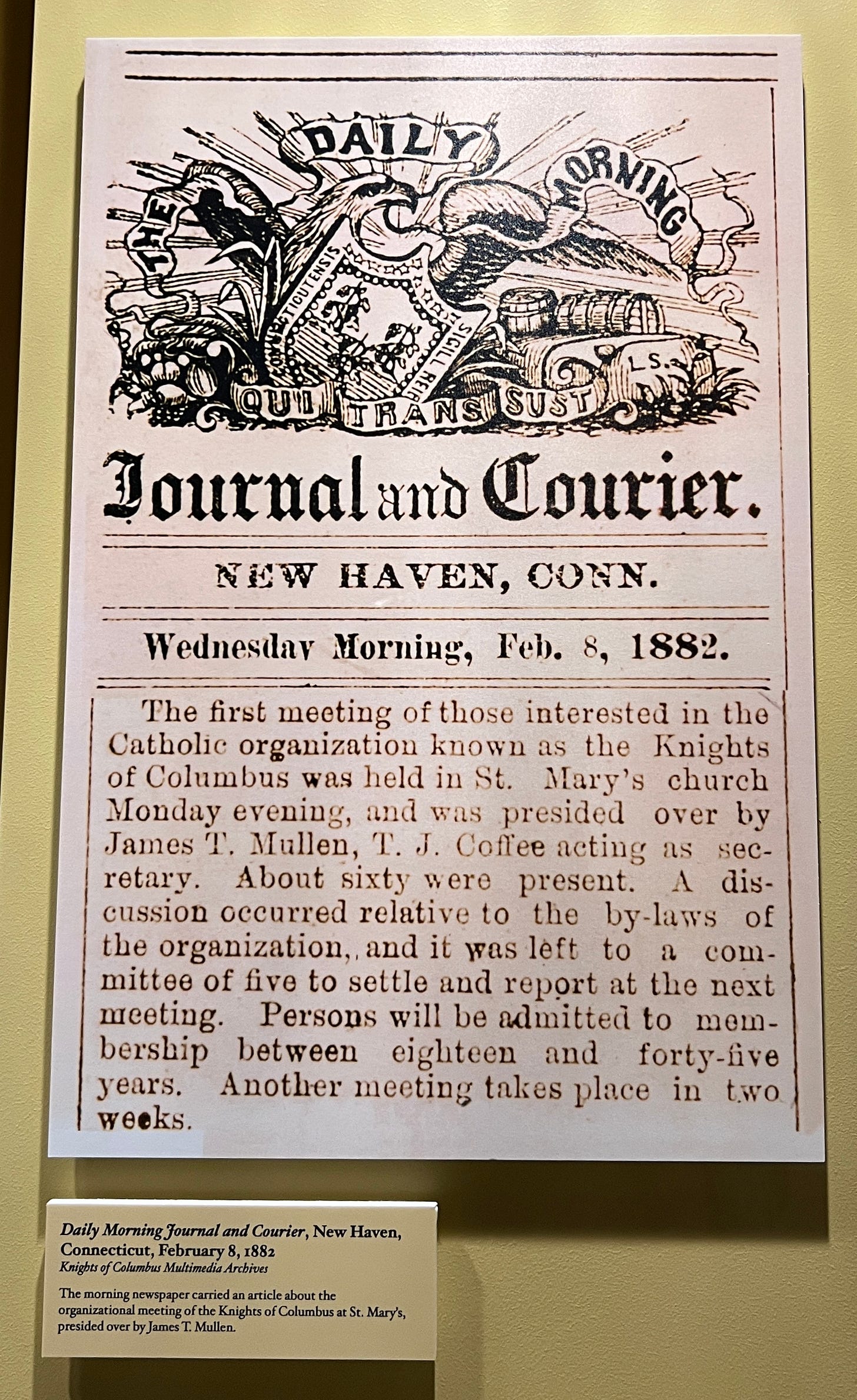
His goal with the Knights of Columbus was to build fellowship among Catholic men, to support Catholic families, and to further the acceptance of the Irish and of the Catholic faith in the culture at large.
My recent exposure during the previous week’s travel to the details of the spectacularly gruesome martyrdom of the North American martyrs on visits to their shrines in Ontario and upstate New York led to this question I wanted to answer about Blessed McInvney, “What kind of holiness did an ordinary parish priest have that would make him worthy of being proposed for sainthood?”
After all, this in-many-ways-ordinary priest did not make hazardous ocean crossings or trek through wildernesses or die an agonizing death after mock baptisms with boiling water or have his fingers chewed off as did some of the Jesuit martyrs I’d been learning about.
Our first stop was the Blessed Michael McGivney Pilgrimage Center, which was formerly known as the Knights of Columbus Museum. The building was erected in the Brutalist style in 1965 and purchased by the Knights of Columbus in 1982 originally to house their museum and their archives. Immediately after Fr. McGivney was beatified on Oct. 31, 2020, the building was rededicated on Nov. 1, 2020, and was given its present title.

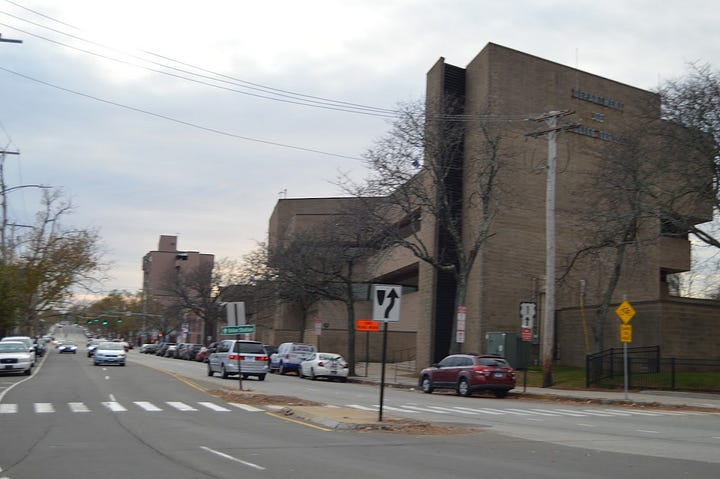
On our way off the freeway to get to the pilgrimage center, we’d noticed another unusual building, which as it turned out is the Knights of Columbus International Headquarters (1 Columbus Plaza). Photos below. The 23-story office building with its unique four rounded brick-work towers was designed to be hard to miss by Kevin Roach, a famous modernist architect. It was intended to stand out above a newly created freeway and to be a gateway to New Haven’s then-recently redeveloped downtown.
The Knights’ website says the four tours symbolize the Knights’ principles of charity, unity, fraternity, and patriotism.
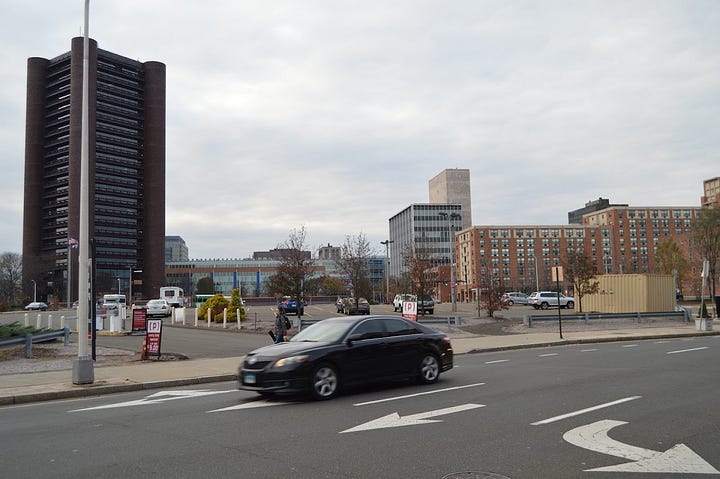
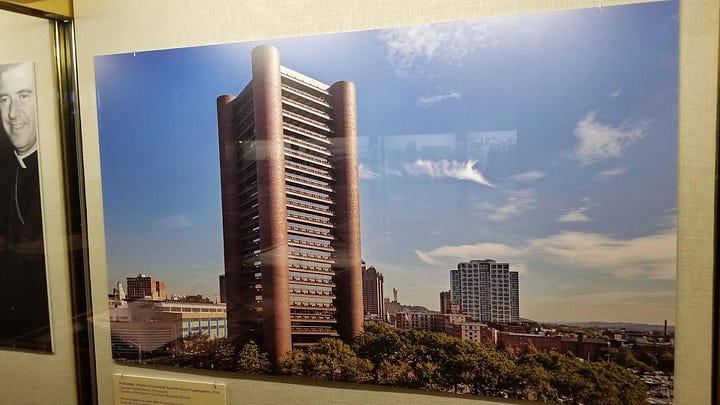
That’s all she wrote for now.
I’d appreciate any reaction you can share with me about the tone of what I’ve written, its level of detail, and how interesting you find it (or not). Your approval, if gained, and in any case your suggestions will make it easier to continue.
[1] Catholic Literary Arts, which is directed by its founder, widely published poet and zealous educator, Sarah Cortez, presents many programs to aid Catholics and other writers of good will in gaining the skills and the community that can help them produce works of the highest quality and help Catholic writers, in the words of poet and culture critic Dana Gioia, “to renovate and reoccupy our own tradition.” The CLA Virtual Happy Hours are advertised this way, “Do you wish you were more involved with a community of Writers of Faith? If so, join us for a social hour of introductions and camaraderie? Check at catholicliteraryarts.org for https://www.facebook.com/cathla.org/
[2] Want to Help Me Jumpstart a Book?
[3} G. M. Baker writes he is trying to revive the serious popular novel, “the kind of story that finds the truth of the human condition in action, adventure, romance, and even magic.” He authors the Substack newsletters, Stories All the Way Down, Ordinary Eccentricity, and Why I Am Still Catholic, and is the author of the historical novels The Wistful and the Good, St. Agnes and the Selkie, and the fairy-tale fantasy Lady Isabel and the Elf Knight.

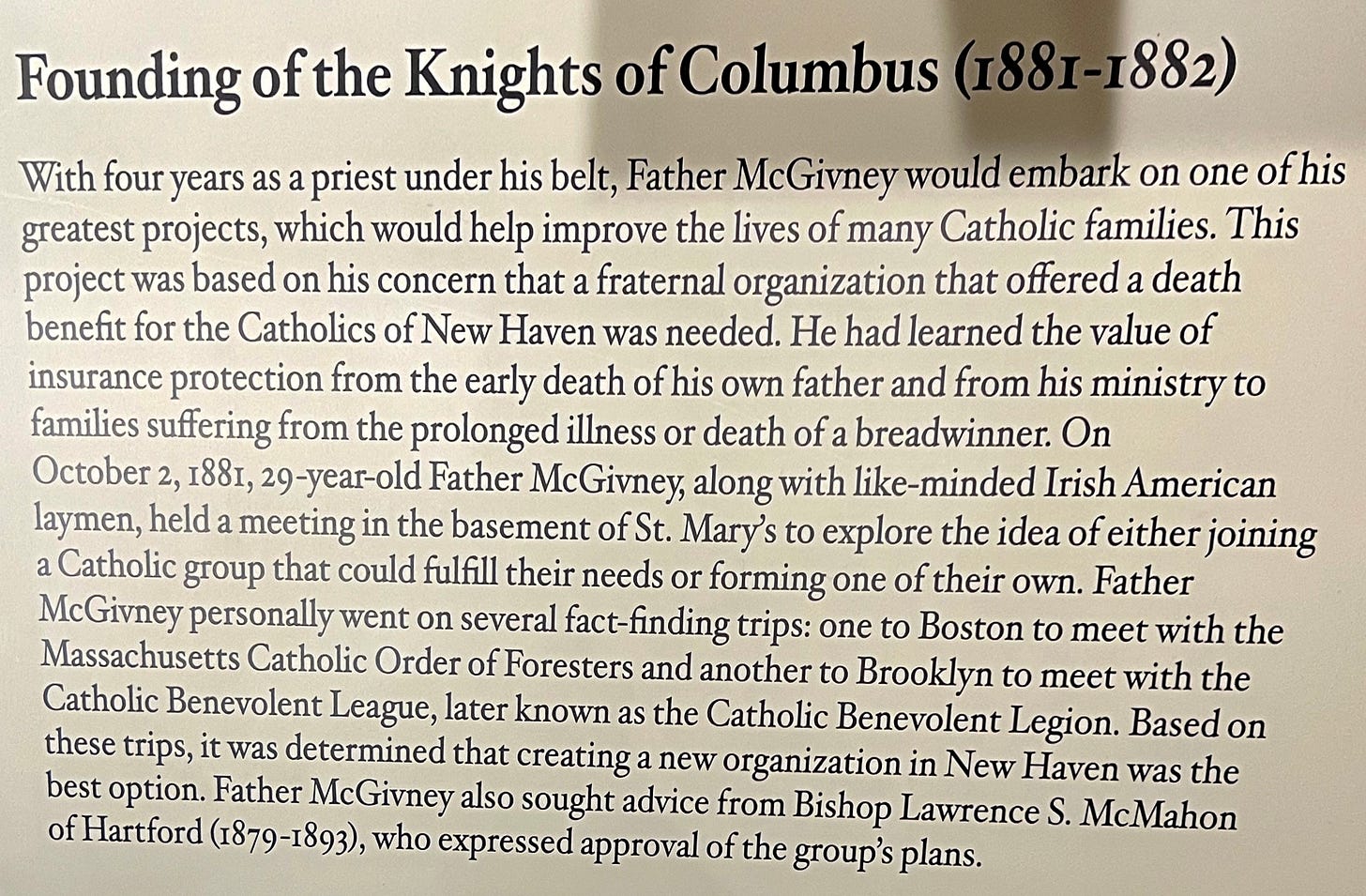

Another comment from an email:
I am struggling with a new "impossible" deadline of my own, but here are a few ideas both in response to your original writing and to the new post.
For this reader, the stream-of-consciousness method feels too imprecise and free-wheeling. I prefer a clear narrative with careful placement of themes and details. So a good author to study would be Kathleen Norris who is always in control of both her narrative and her themes.
I absolutely (forgive me--this is going to sound emphatic) don't suggest you follow that Japanese author. We had to read her book in a summer residency program two years ago and EVERYONE hated it. And these were sophisticated, well-read, literary, adult students. She put everyone off with her personality and the i-novel is not a form that Westerns know how to relate to or like. And even with studying the i-novel form and history, everyone still hated the book.
As a reader I don't find the author's history to add much to your story. Perhaps this is because the anecdotes are too black and white. Perhaps, they sound too judgemental. Could they be deleted or presented in a more nuanced fashion? How would it feel to be less Mary Carr and more Kathleen Norris? If you intend that the book be mostly a memoir which "writes" two different pasts: the past of the saint and the past of the author, then the payoff for the reader is getting to know both in a deeper fashion. Therefore, the persona on the page of them both has to be engaging, appealing, and in particular for the author, nuanced and wise.
These few thoughts are meant to help rather than be unhelpful, but as they say in AA, please feel free to disregard what won't be helpful. I've seen your polished writing and I'm sure your skills are up to it!
Big hugs,
S
Another comment from an email: Good job! I read what You wrote & Loved it...sounds interesting! :) Can't wait to read some more when You're ready... 😌🙏📿